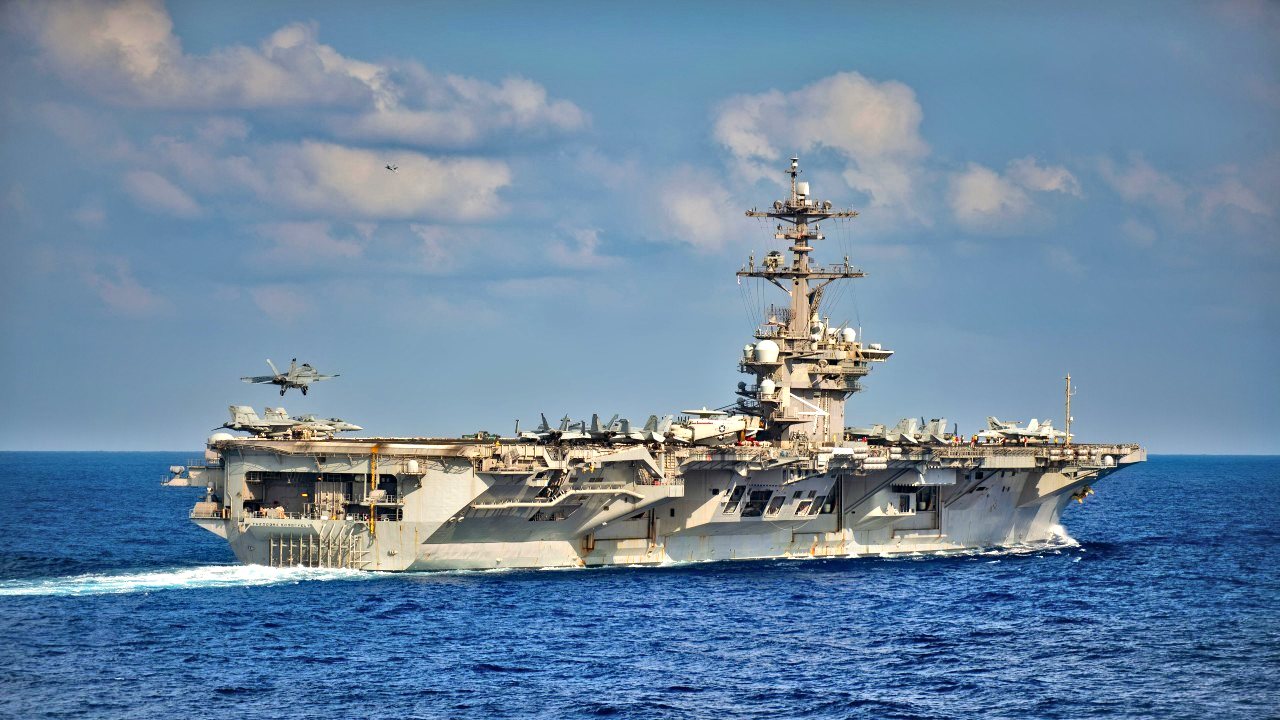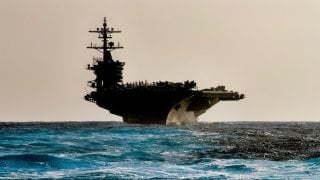Could U.S. Navy Aircraft Carriers Be Used as 'Tactical Distractions' in War?
The U.S. Navy's reliance on aircraft carriers, despite their high costs and growing vulnerability to anti-access/area-denial (A2/AD) systems, has raised strategic concerns.
Summary and Key Points: The U.S. Navy's reliance on aircraft carriers, despite their high costs and growing vulnerability to anti-access/area-denial (A2/AD) systems, has raised strategic concerns. The $13 billion Gerald R. Ford-class carriers, designed for long-range power projection, face new threats from advanced missile systems that can locate and target them from over 1,000 kilometers away.

-Suggestions to use carriers as tactical distractions draw comparisons to historical naval battles but overlook the potential for significant losses and the current fragility of the U.S. defense industrial base.
-Instead of focusing on carriers, the Navy should prioritize developing hypersonic weapons, unmanned underwater vehicles, submarines, and directed-energy weapons to counter the A2/AD threat. This shift is essential to maintain naval superiority and effectively respond to modern strategic challenges.
The Navy Might Use Its Aircraft Carriers as Distractions
Outside of nuclear weapons, America’s aircraft carriers are probably the country’s biggest long-term strategic investment. The newest Gerald R. Ford-class carriers cost an astonishing $13 billion per unit, although the Navy insists that costs decrease with each new unit they build.
Since the Second World War, when aircraft carriers proved their mettle in the Pacific Theater, Washington has made the flattop its primary platform for long-range projection of naval power.
But the world has moved on.
Specific technologies like the anti-ship ballistic missile pair with comprehensive approaches like China’s anti-access/area-denial (A2/AD) strategy to negate many of the advantages the aircraft carrier once bestowed. The sheer cost of these platforms means that losing even one in combat – or having one significantly damaged – could punch a hole in the United States’ strategic posture, with horrific cascading effects throughout the rest of the force.
America's Obsession with Aircraft Carriers is Dangerous
The Navy, of course, understands the changing reality it now faces.
Yet it has done little to address the A2/AD threat. Instead, Washington continues flooding hard-earned U.S. tax dollars into building more expensive flattops whose utility is in question under present strategic conditions. If the aircraft carrier cannot get within range of a contested battlespace during a crisis, then it cannot launch its airwing. If it cannot launch its airwing, its usefulness as a power projection platform is erased.
What’s more, these large systems are increasingly easy for rival A2/AD systems to locate, track, and target with extremely long-range weapons that are devastatingly precise.
The threat of A2/AD attacks could keep an American carrier force over the horizon of a contested battlespace. Some of these systems have a range over 1,000 kilometers.
A Distraction Won’t Work
Trevor Phillips-Levine and Andrew Tenbusch, writing in Maritime Executive, suggest using America’s aircraft carriers as a ruse in any tactical situation. Drawing inspiration from the Imperial Japanese Navy during the Battle of Leyte Gulf, the two authors argue the United States should deploy their carriers as a means of distracting a potential rival in a naval battle long enough for non-carrier units to be used more effectively in combat by the Americans. It’s an interesting suggestion.
The Japanese had correctly assumed that American intelligence analysts would detect the mass movement of Japanese warships and fixate on the presence of aircraft carriers. Japanese strategists understood that the Americans placed a high value on their own carriers, and they correctly postulated that the Americans would assume the Japanese similarly valued theirs.
Japan got one over on the Americans.
Of course, what the authors fail to mention is that while the Japanese diversion at the Battle of Leyte Gulf was successful in tricking the bulk of the American fleet, it ultimately ended in failure. Not only did the Americans still win the battle, they went on to win the whole war not long after that incident.
One of the biggest issues facing Japan by the time this specific battle occurred was that the Imperial Japanese Navy, like the rest of the Japanese military, no longer had a healthy industrial base supporting their efforts. The forces deployed against the Americans were basically all that was left of the Japanese military.
Once those Japanese units were stymied, that was it for Tokyo.
America’s Broken Defense Industrial Base
The United States today, while much larger than Japan was, is in a similar predicament. Its shipyards are in shambles. The U.S. Navy is the smallest it has ever been. The military is saddled with massive, complex, and costly systems. Losing one in combat would deal a crippling blow to American morale and to its overall strategic posture.
The greater defense industrial base is lying prostrate, too, after years of being gutted by short-sighted financial interests, inconclusive Mideast wars, and a wasteful commitment to the lost Ukrainian cause.
If the United States and China find themselves at war, the Americans will be at a serious disadvantage.
Further, U.S. carriers are far too costly to risk in a ruse. Even if the maneuver were successful, the U.S. lacks requisite platforms to serve as alternative power projection units in a contested environment. A2/AD is a threat to all surface combatants, and the U.S. fleet is woefully lacking in submarines.
Sly moves and strategic feints, while always a necessity in combat, will not save the U.S. from its overcommitment to aircraft carriers. Instead, the Americans must develop counter-A2/AD systems and strategies. Once an A2/AD network is removed as a threat, more conventional moves by the Americans, such as deploying aircraft carriers, can be attempted.
What Must Be Done Instead
Instead of ruses, the Navy needs to focus on building hypersonic weapons, swarms of unmanned underwater vehicles, more submarines, and directed-energy weapons, for starters. Other services must back up the Navy in these endeavors.
The overcommitment to expensive, massive flattops has created a severe vulnerability the likes of which have not been since the Royal Navy’s HMS Hood was sunk within the first five minutes of its major engagement with Hitler’s navy.

Breaking the A2/AD web that China has created throughout the Indo-Pacific is the first, and only, priority of the U.S. Navy. Its carriers are useless until A2/AD can be overcome.
Author Experience and Expertise: Brandon J. Weichert
Brandon J. Weichert, a National Interest national security analyst, is a former Congressional staffer and geopolitical analyst who is a contributor at The Washington Times, the Asia Times, and The-Pipeline. He is the author of Winning Space: How America Remains a Superpower, Biohacked: China’s Race to Control Life, and The Shadow War: Iran’s Quest for Supremacy. His next book, A Disaster of Our Own Making: How the West Lost Ukraine, is due October 22 from Encounter Books. Weichert can be followed via Twitter @WeTheBrandon.
All images are Creative Commons or Shutterstock.
From the Vault
Russia Freaked Out: Why the U.S. Navy 'Unretired' the Iowa-Class Battleships
Battleship vs. Battlecruiser: Iowa-Class vs. Russia's Kirov-Class (Who Wins?)


